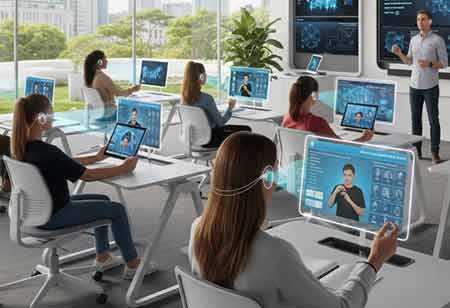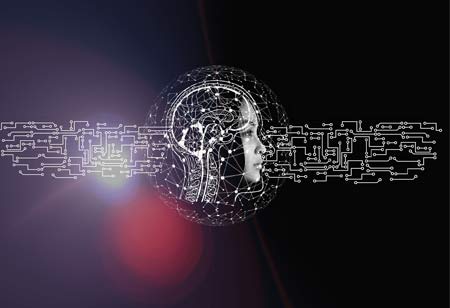THANK YOU FOR SUBSCRIBING
Be first to read the latest tech news, Industry Leader's Insights, and CIO interviews of medium and large enterprises exclusively from Education Technology Insights
The Role of Technology in the Modern Classroom
Emerging technologies in education enhance auditory accessibility, creating inclusive learning environments through smart soundscapes, AI-driven tools, and personalized audio experiences for all students.

By
Education Technology Insights | Friday, August 22, 2025
Stay ahead of the industry with exclusive feature stories on the top companies, expert insights and the latest news delivered straight to your inbox. Subscribe today.
FREMONT, CA:The educational landscape is driven by emerging technologies that are creating more inclusive and engaging learning environments. A significant area of innovation lies in auditory accessibility, where advancements are reshaping how students with hearing impairments, as well as all learners, interact with sound in educational settings. This shift towards "smart soundscapes" is leveraging cutting-edge tools to dismantle barriers and enhance comprehension for diverse auditory needs.
The Evolving Landscape of Auditory Accessibility
Auditory accessibility in education was centered on assistive listening devices such as hearing aids and cochlear implants, supplemented by strategies including preferential seating and the use of sign language interpreters. While these measures remain indispensable, recent technological advances are expanding the possibilities of inclusive learning environments. The focus is shifting from fundamental amplification to the creation of intelligent, adaptive soundscapes that enhance comprehension and engagement for diverse learners.
One of the key drivers of this evolution is the advancement of assistive listening devices (ALDs). Modern systems, including FM transmitters and induction loops, deliver superior noise reduction and sound clarity. By transmitting audio directly from a teacher’s microphone to a student’s hearing aid or receiver, these devices significantly improve speech intelligibility in noisy classrooms. Complementing this, real-time transcription and captioning powered by artificial intelligence and natural language processing ensure immediate visual access to spoken content. This not only supports students with hearing impairments but also benefits language learners and students who prefer to follow lectures through text.
AI is also transforming personal hearing technologies. Next-generation hearing aids now utilize machine learning to distinguish between background noise and human speech, automatically adapting to the user's preferences and environmental contexts. Similarly, personalized audio-based learning platforms are emerging, offering customized audio content tailored to each student’s pace, style, and engagement. These platforms incorporate natural-sounding text-to-speech synthesis and interactive dialogue-based learning through conversational AI, creating more inclusive and engaging experiences.
The integration of auditory accessibility within smart classrooms represents another significant development. Audio systems are increasingly interconnected with interactive whiteboards, personal devices, and classroom management technologies, enabling flexible audio routing, intelligent amplification, and AI-driven adjustments that respond to participation levels and room dynamics. In parallel, educators are recognizing the role of ambient sound in shaping learning environments. Biophilic soundscaping, which incorporates natural auditory elements, is gaining traction as a way to mask distractions, reduce stress, and enhance focus—benefiting not only students with hearing sensitivities but the entire classroom community.
Benefits and Impact on Education
The integration of smart soundscapes into educational environments offers a transformative range of benefits that enhance both teaching and learning experiences. Most notably, these technologies foster genuine inclusivity by enabling students with hearing impairments to fully engage in classroom activities through real-time access to verbal information, thereby breaking down long-standing communication barriers. Beyond accessibility, features such as live captions and enhanced audio clarity also support a broader spectrum of learners, including those with auditory processing challenges, English as a Second Language (ESL) students, and individuals who benefit from multimodal learning approaches. By reducing reliance on interpreters or one-on-one assistance, smart soundscapes promote greater independence, empowering students to access information at their own pace. Furthermore, AI-driven personalization tailors learning experiences to individual needs and preferences, fostering more effective and engaging outcomes. These systems also alleviate cognitive strain by filtering background noise and clarifying speech, allowing students to focus more deeply on comprehension and critical thinking. Additionally, advanced platforms can provide valuable data-driven insights into classroom acoustics and student engagement, equipping educators with actionable information to continually refine and optimize the learning environment.
Smart soundscapes are not just about amplifying sound; they are about intelligent design, personalized experiences, and fostering an environment where every student's voice can be heard and every lesson can be understood. As technology continues to evolve, these innovative solutions will undoubtedly play a pivotal role in shaping an accessible and equitable future for education.







